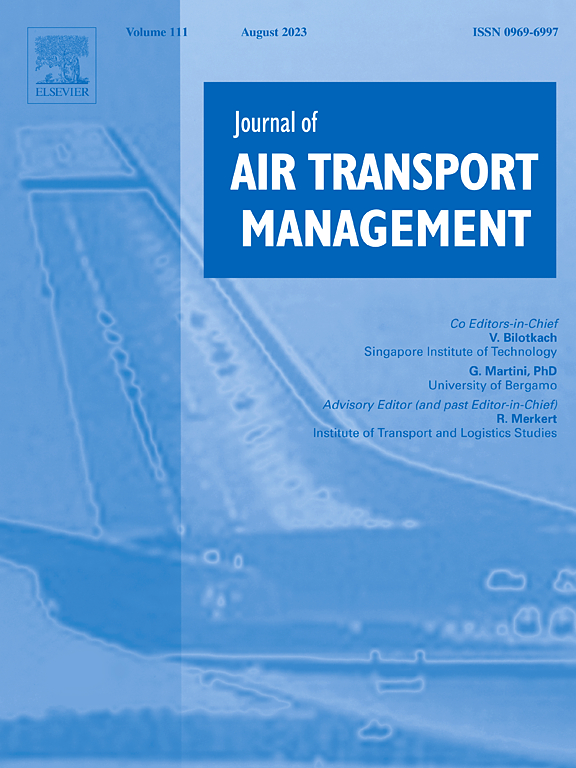以飞行为中心的复杂性和分配给控制器的飞行
IF 3.6
2区 工程技术
Q2 TRANSPORTATION
引用次数: 0
摘要
在最近用于空中交通管理的基于轨迹的操作(TBO)框架中,这种通信解决了将航班分配给管制员的问题。采用了一种新的以飞行为中心的空中交通复杂性度量方法来表征每个航班的交通复杂性,从而量化管制员监督所带来的工作量。在TBO框架内,在战术前层面,提出了一个原始的以飞行为中心的航班到管制员的最优分配问题。这个问题的解决,一方面决定了给定时间内的管制规模,这只是向ATCO全天工作人员的全部规模迈出的一步,另一方面,在管制员和他们监管的相应航班之间实现交通管制工作量的最佳分配。这种组合问题的计算复杂性导致了近似解方法的发展来处理它。在可接受的计算成本下,有效地开发了一种启发式方法,以提供可行的解决方案,允许处理大维度的问题。通过实例比较了启发式算法与三种实际方法的性能。所提出的启发式方法似乎优于这些方法,并且可以从中预期的性能是:关于容量限制的可行性,控制器团队之间的交互最小化,以及平衡的工作负载分配。然后,介绍了战术问题,并讨论了直接或间接基于引入的以飞行为中心的复杂性度量的不同方案,以应对作战干扰和空中交通冲突。本文章由计算机程序翻译,如有差异,请以英文原文为准。
Flight centric complexity and allocation of flights to controllers
Within the recent Trajectory Based Operations (TBO) framework for air traffic management, this communication addresses the problem of assigning flights to controllers. A new flight centric complexity measure of air traffic is adopted to characterise the traffic complexity of each flight and then to quantify the workload resulting from its supervision by controllers. Within the TBO framework, at the pre-tactical level, an original flight centric optimal assignment problem of flights to controllers is formulated. The solution of this problem determines, on the one hand, the size of the control during a given period of time, which is only a step towards the full sizing of the ATCO workforce for an entire day and, on the other hand, an optimal distribution of the traffic control workload between controllers and the corresponding flights under their supervision. The computational complexity of this combinatorial problem leads to the development of an approximate solution method to deal with it. A heuristic is effectively developed to provide a feasible solution at an acceptable computational cost, allowing the treatment of problems of large dimension. A case study is presented to compare the performance of the solution provided by the heuristic with three practical methods. The proposed heuristic appears to be superior to these methods, and the performances that can be expected from it are: feasibility with respect to capacity constraints, minimisation of interactions between controller teams, and balanced workload distribution. Then, tactical issues are introduced and different schemes, all based directly or indirectly on the introduced flight centric complexity measure, are discussed to face operational disturbances and air traffic conflicts.
求助全文
通过发布文献求助,成功后即可免费获取论文全文。
去求助
来源期刊

Journal of Air Transport Management
TRANSPORTATION-
CiteScore
12.40
自引率
11.70%
发文量
97
期刊介绍:
The Journal of Air Transport Management (JATM) sets out to address, through high quality research articles and authoritative commentary, the major economic, management and policy issues facing the air transport industry today. It offers practitioners and academics an international and dynamic forum for analysis and discussion of these issues, linking research and practice and stimulating interaction between the two. The refereed papers in the journal cover all the major sectors of the industry (airlines, airports, air traffic management) as well as related areas such as tourism management and logistics. Papers are blind reviewed, normally by two referees, chosen for their specialist knowledge. The journal provides independent, original and rigorous analysis in the areas of: • Policy, regulation and law • Strategy • Operations • Marketing • Economics and finance • Sustainability
 求助内容:
求助内容: 应助结果提醒方式:
应助结果提醒方式:


